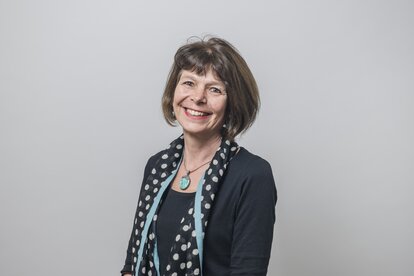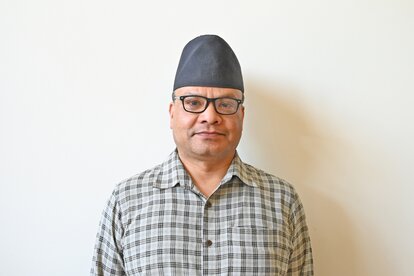The offices of Kankai municipality (nagarpalika) are within a few minutes’ drive from Nepal’s main East – West highway; at the time of our visit, paddy ready for harvest was golden in the fields, and a general air of prosperity was apparent in neatly kept buildings along the road. The municipality building is under expansion but is already spacious and well-appointed by comparison with many others in the country. Mayor Rajendra Pokharel and Deputy Mayor Manju Prasai were both waiting to greet us and talk about their work.
A thriving municipality
With a population of some 48,181 (2019 figures), Kankai is one of the largest and most developed municipalities in Jhapa, province 1 (Eastern Nepal). Lying on the flat plains of the Terai, it benefits from a good road and electricity network as well as fertile agricultural land. Officially, 95% of households have access to safe drinking water and to national grid electricity, whilst only 4.8% have less than six months food self-sufficiency – although that has not stopped 10% of the population seeking employment abroad. The municipality estimates that these workers send back remittances of some NRs 540,000 (around USD 4,700) per day
Given this relative affluence, why is Helvetas working in Kankai? This is being done under the Interim Capacity Support for Federalism Project (ICSFP), an SDC project implemented by Helvetas. In fact, the support provided is very small in financial terms, and is technical, not material. It makes sense in the context of Nepal’s nascent federalization process: working with selected municipalities to develop effective, transparent and accountable systems is fundamental to supporting good local governance.
Having a vision and a development plan
Our support began with facilitating a series of consultation meetings with municipal staff – both the elected representatives and administrative officers – to determine a development vision for the municipality. Having decided on their vision of "Improved heritage, sustainable infrastructure: Prosperous Kankai, our core base", the municipality started thinking in terms of outcomes – not simply specific outputs. What, within the bounds of budgetary feasibility, do they want to see achieved within five years? What should take priority? Since a significant number of Kankai citizens are living in Kathmandu, we also organized a consultation meeting in the capital, giving these people the opportunity to contribute their views to the draft development plan. The plan was then finally validated in a workshop in Kankai. In the last financial year, the municipal budget came to NRs 497,900,000 (approx. USD 4,367,500). In the current financial year, it is NRs 737,500,000 (approx. USD 6,469,300).
Identifying ways to generate local revenue
Municipalities receive the bulk of their funding from federal (and to a lesser extent, provincial) coffers – although to receive their budgetary quota, they must have the systems in place to apply and account correctly for their expenditure. Since Kankai municipality has plans that go beyond that which these funds will cover, they were very interested in identifying means to increase their own revenue. In any case, local revenue generation is important for sustaining development interventions – and reinforces the need for municipalities to demonstrate transparency and accountability. The Local Government Operation Act (2017) sets out a variety of local revenue sources; together, we analyzed these, identified existing revenue sources, gaps in capacity, budgetary trends, and the functioning of the revenue administration system. We also explored potential revenue sources that were not being tapped. As a result of this work, we together prepared a Revenue Improvement Action Plan. This has been extremely effective. In the last financial year, the municipality collected NRs. 42,090,000 (approx. USD 369,200) in local revenue. In the current financial year, the local revenue is expected to be NRs 61,848,000 (approx. USD 542,500) - almost a 47% increment over last year.
“The rate of property tax was flat at 10% per household per annum, but people tried to avoid payment however they could, and revenue was low. So, we introduced what we call progressive taxation. Those with an annual income of less than NRs 50,000 pay 1%, those earning up to NRs 100,000 pay 2%, and so on – only commercial institutions and the very wealthy must pay 10%. Slowly we can improve our services in return. People see that we are black-topping the roads; that we provide health insurance to those senior citizens who cannot afford health care; that we are providing free household electricity meters, that we are building homes for homeless citizens. Then they are willing to pay their taxes.” Rajendra Pokharel, Mayor
Rajendra Pokharel also points out that Kankai is Open Defecation Free (all residents have access to a toilet), has no electricity leakages, is free of strikes, and is environmentally conscious. Chief amongst the “green” initiatives is the establishment of a biogas plant using organic waste - a collaborative effort between Kankai and two neighboring municipalities. Meanwhile, in addition to overseeing important constitutional responsibilities, Deputy Mayor Manju Prasai is spearheading a nutrition program for pregnant women and breastfeeding mothers. There is no shortage of development ideas.
Ultimately, a voice over their own future and over the development of their locality was what many Nepalese fought and died for during Nepal’s armed conflict. Given its existing resources, Kankai municipality might be in a better position than some to transform its vision of local development into reality. Nevertheless, in providing a demonstration of what is possible at municipal level under a federal system, it offers a positive role model to others.



